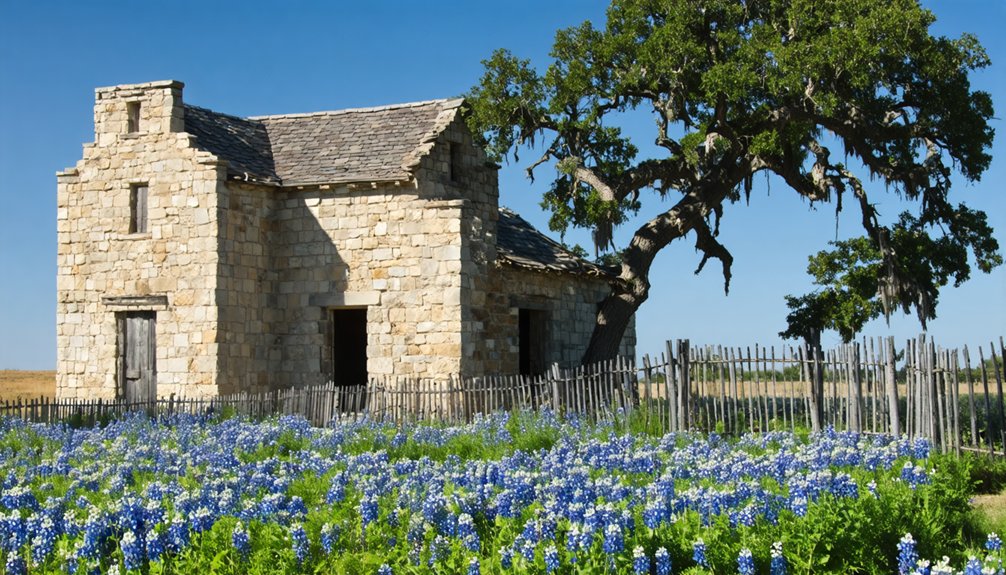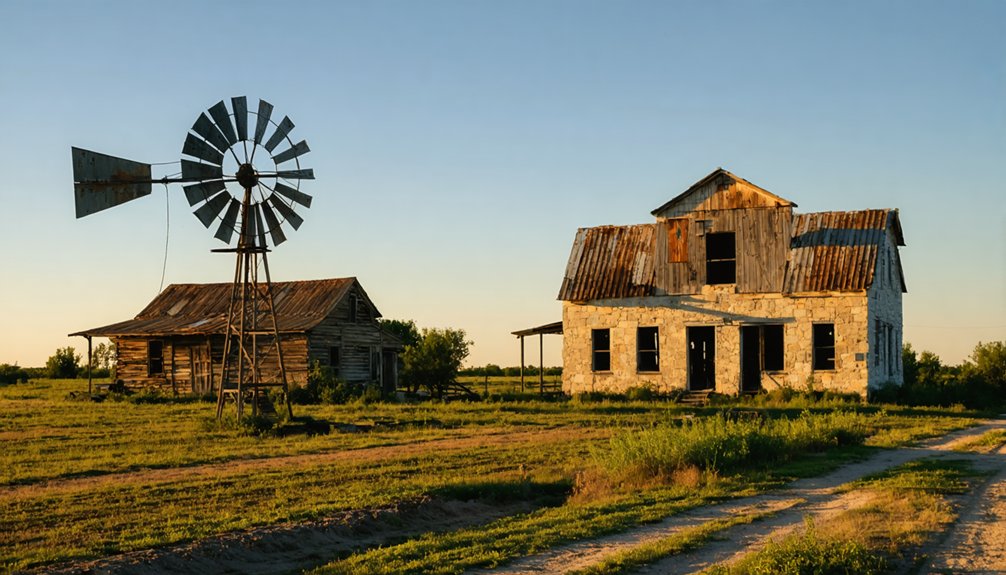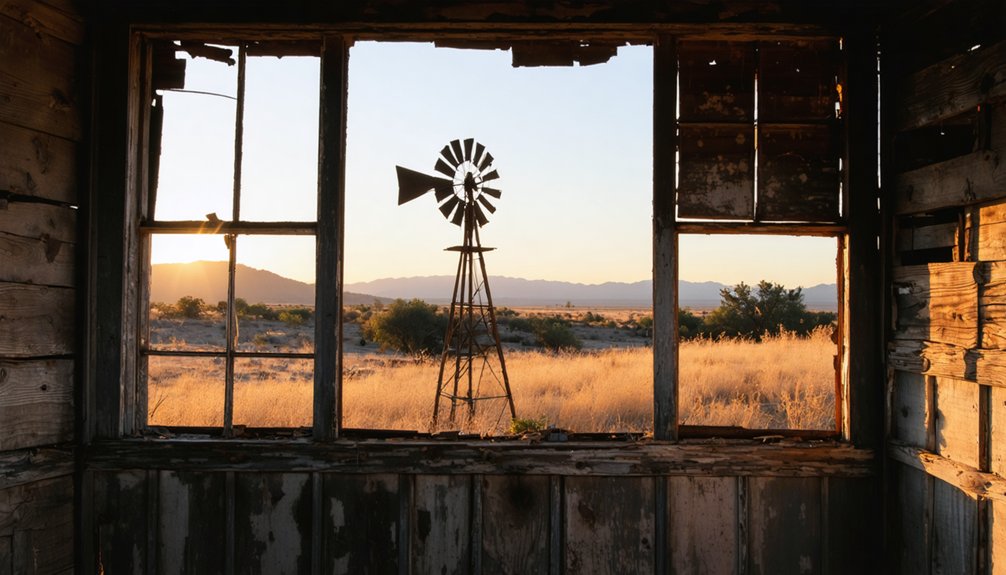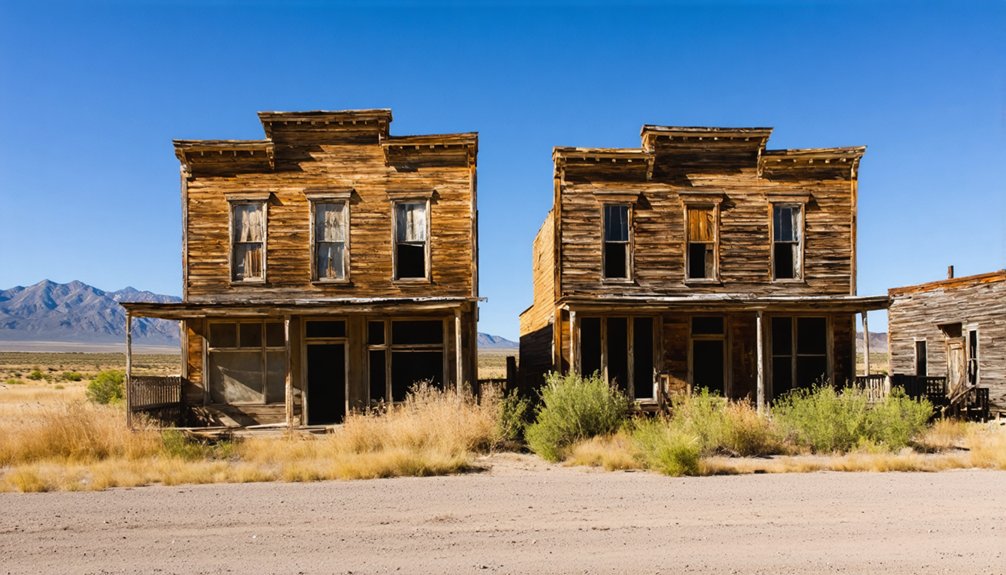You’ll find Twin Sisters, Texas perched at 1,762 feet in Blanco County’s Hill Country, where German immigrants first settled in 1854. The town flourished as an agricultural center with a post office, gristmill, cotton gin, and three general stores by 1890. Despite its promising start, severe droughts and changing transportation routes led to its decline. Today, this ghost town‘s abandoned structures and quiet streets tell the story of a once-vibrant community’s dramatic transformation.
Key Takeaways
- Twin Sisters was established in 1854 by German immigrants and Joel Cherry, developing into a thriving agricultural community with stores and mills.
- Located at 1,762 feet elevation in Texas Hill Country, the town features distinctive Twin Hills and limestone formations.
- Severe droughts and new highway construction bypassing the town led to its economic decline and eventual ghost town status.
- The population decreased to 78 residents between 1970-1990, with most businesses closing and community centers ceasing operations.
- Today, Twin Sisters stands mostly abandoned, with remaining structures serving as remnants of its once-vibrant rural community life.
The First Settlers of Twin Sisters
As German immigrants began settling the Twin Sisters area of southern Blanco County in 1854, Joel Cherry from Tennessee became the region’s first documented settler.
You’ll find that the German settlers quickly formed the core of this growing community, establishing their cultural traditions alongside English settlers who arrived in the late 1850s.
The settler experiences centered around the area’s most distinctive feature – two prominent hills that gave Twin Sisters its name. Like the famous Twin Sisters cannons used in the Texas Revolution, the hills became an important symbol of the region’s identity.
The citizens of Cincinnati had shown similar community spirit when they raised $600 to fund the historic cannons in 1835.
These early pioneers showed their commitment to building a lasting community by successfully petitioning for a post office in 1856, one of the settlement’s first formal institutions.
The establishment of Twin Sisters’ post office in 1856 marked a crucial milestone in transforming this frontier outpost into an enduring settlement.
While Native Americans had inhabited the region centuries earlier, by the 1850s the European settlers were establishing their own multicultural community in this Texas frontier.
Geographic Features That Shaped the Town
You’ll find Twin Sisters situated at an elevation of 1,762 feet in the Texas Hill Country, where its distinctive twin hills served as natural landmarks for early settlers.
The town’s location at coordinates 29.980491°N, 98.4466862°W placed it in a landscape dominated by limestone formations typical of Blanco County’s terrain. Modern visitors must complete human verification steps before accessing certain historical site information online to protect against automated data scraping.
Like many semi-abandoned towns across Texas, Twin Sisters has experienced significant population decline over the decades. The surrounding vegetation of scrub oak and cedar trees reflects the Hill Country’s characteristic flora, though specific information about local water features remains limited in historical records.
Landmark Twin Hills Location
The iconic Twin Hills rise prominently above the Little Blanco River valley, serving as the namesake geographic feature that defined Twin Sisters’ early development.
These natural landmarks didn’t just shape the town’s identity – they influenced its entire layout and function. You’ll find these distinctive hills commanding attention from their strategic position, where they’ve historically served as both observation points and natural boundaries for the settlement. Similar to the Ladies of Cincinnati who gifted important landmarks to Texas history, the hills became a cherished symbol of the community’s heritage. When artillery was needed in 1835, the hills provided an ideal location for mounted cannons to protect the region.
- Positioned at the heart of the community, affecting residential and commercial development patterns
- Created natural limits for town expansion while providing elevated vantage points
- Influenced the placement of key structures like the dance hall and cemetery
- Formed a backdrop for local cultural narratives and community gatherings
The hills’ geographic significance extends beyond mere aesthetics, fundamentally directing the town’s spatial organization and growth throughout its history.
Regional River Access Points
Beyond Twin Hills’ commanding presence, river access points along the Guadalupe River played a significant role in shaping Twin Sisters’ development and character.
A scenic corridor of limestone cliffs and cypress lines the riverway, creating a stunning natural backdrop for visitors and residents alike.
You’ll find numerous commercial and public access points between Canyon Dam and Gruene, spanning roughly 7 miles of diverse waterway. These strategic locations offer year-round recreational opportunities for rafting, kayaking, and fishing.
Key river features like Devil’s Playground, Huaco Falls, and The Chute create natural gathering spots where limestone channels and rapids define the landscape. In winter months, GRTU stocks trout throughout accessible sections of the river, attracting anglers from across the region.
While private property lines much of the riverbank, you can access the water through commercial outfitters at spots like 306 Bridges, 4th Crossing-RioRaft, and Lazy L&L.
The Texas Parks and Wildlife’s lease program also maintains select public river access areas, though availability may vary with seasonal conditions.
Local Limestone Rock Formations
Imposing limestone formations dominate Twin Sisters’ geological landscape, with Trinity Group deposits creating distinctive terraced terrain that shaped the town’s development.
You’ll find these limestone geology features rising 750 feet above the basin floor, forming cliffs and canyons that influenced settlement patterns and water access. The rock formations consist of Glen Rose Limestone, featuring alternating layers of marl and sandstone that weather into natural staircases. The hard limestone strata alternate with softer marl layers throughout the formation, creating the stepped appearance of the landscape.
- Lower Cretaceous deposits contain fossil evidence of dinosaurs like Acrocanthosaurus and Tenontosaurus
- Limestone strata create natural landmarks that historically aided navigation
- Karst features impact local groundwater movement through the Trinity aquifer
- Rock layers reveal a prehistoric shift from terrestrial to shallow marine environments
The area’s rich paleontological significance is further demonstrated by the presence of Sauroposeidon proteles fossils within these ancient rock formations.
Early Community Development and Growth
Twin Sisters’ early community development began in 1854 when Joel Cherry established the first settlement, soon attracting German and English immigrants to the area.
By 1856, the settlers had successfully petitioned for a post office, marking the town’s first major infrastructure milestone.
The growing community supported small-scale agriculture and local trade, with early homes often serving dual purposes as community gathering spaces and eventual auction houses.
Initial Settlement Patterns
As German immigrants and English settlers began establishing homes near the Little Blanco River in 1854, the settlement of Twin Sisters took shape around two distinctive hills that would give the community its name.
The settlement patterns reflected the broader German migration into central Texas, with cultural influences quickly emerging in the area’s social fabric and architecture.
Key aspects of Twin Sisters’ initial development included:
- Joel Cherry from Tennessee leading the first wave of pioneers
- Strategic location near the Little Blanco River providing essential water resources
- Fertile soil supporting agricultural and ranching activities
- Establishment of a post office by 1856, marking formal community recognition
The multi-ethnic character of Twin Sisters emerged as both German and English-speaking settlers integrated into the growing frontier community, creating a diverse cultural foundation.
Community Infrastructure Development
Following the initial wave of settlement, Twin Sisters’ community infrastructure emerged through careful development of religious, commercial, and transportation networks.
You’ll find that churches, particularly the Evangelical Lutheran Church and St. Mary’s Chapel, served as cornerstones of community cohesion and social infrastructure.
The town’s commercial backbone included a general store and an auction house, which evolved from a residence to a restaurant before becoming a crucial economic hub.
The town’s position near US Highway 281 initially supported growth, while the confluence of the Little Blanco River and Cherry Creek provided essential water resources.
However, severe droughts, highway realignment, and declining water availability gradually eroded the community’s foundation.
Despite establishing houses, schools, and religious facilities, Twin Sisters couldn’t sustain its infrastructure as population declined and services disappeared.
Agricultural Business Growth
Since Joel Cherry’s homestead establishment in 1854 near the Little Blanco River, Twin Sisters rapidly developed into a thriving agricultural center.
The town’s economic diversification was driven by a mix of English and German immigrants who shaped the farming community’s character. You’ll find agricultural innovations were central to the town’s growth, with Max Krueger’s gristmill and cotton gin serving as cornerstones of local commerce.
Key developments that transformed Twin Sisters into an agricultural hub:
- Three general stores supplied essential farming goods by 1890
- Integration of indigenous “Three Sisters” planting techniques enhanced crop yields
- Local processing facilities eliminated long-distance grain transport needs
- Combined farming and ranching operations provided economic stability until the 1894 drought
The Post Office Establishment
When local homesteaders petitioned for mail services in 1856, Twin Sisters gained its first post office on the Little Blanco River, seven miles south of Blanco. The facility quickly became a crucial community hub for German and English settlers, facilitating essential communications and commerce in the developing town.
You’ll find that the post office’s establishment marked Twin Sisters as a legitimate settlement on official maps and records, coinciding with Blanco County’s formation.
The postal services operated from what was likely the Krueger General Store, serving as a central point for mail and goods exchange. This crucial institution supported the town’s growth beyond initial homesteading, helping maintain connections between residents and the outside world until Twin Sisters’ eventual decline into a ghost town.
German Immigration Impact

As German settlers arrived in Twin Sisters around 1854, they brought transformative changes that would shape the community’s cultural and economic landscape for generations. Their arrival, facilitated by the Adelsverein, established a vibrant community that preserved their cultural heritage while adapting to Texas frontier life.
- You’ll find the Twin Sisters dance hall (“Tanzsaal der Zwillinsschwestern”) was the epicenter of social life, hosting monthly gatherings that unified the community.
- German immigrant traditions flourished through shooting clubs, churches, and schools.
- Their agricultural expertise enhanced local farming development with techniques from their homeland.
- The German language and customs persisted well into the 20th century, with many residents speaking German more frequently than English.
These settlers faced considerable challenges, from harsh frontier conditions to unfulfilled Adelsverein promises, yet their determination built lasting foundations in Twin Sisters.
Life in Twin Sisters During the 1850s
The 1850s marked a foundational period for Twin Sisters, building upon the German settlers‘ early influence. You’d find a sparse population of determined settlers focusing on subsistence living, working the land and raising livestock to survive.
Daily life revolved around practical needs, with community gatherings serving as crucial connections between scattered homesteads. Your transportation options would’ve been limited to horse and wagon, making Twin Sisters relatively isolated.
You’d rely on informal education, basic healthcare from family members, and communal support during challenging times. The local economy centered on essential trades and services, while hunting and fishing supplemented your food sources.
You’d participate in traditional social events like barn-raisings and harvest celebrations, strengthening the bonds that held this frontier community together.
Farming and Ranching Legacy

During Twin Sisters’ formative years, German and English immigrants established a robust agricultural foundation that would shape the settlement’s identity.
You’ll find their legacy in the crop diversification they practiced, growing everything from corn to cotton while maintaining vegetable gardens and orchards. Their ranching techniques evolved around open-range grazing of cattle, sheep, and horses on the settlement’s rugged terrain.
- Farmers relied heavily on manual labor and animal power, working with oxen and horses to plow their fields.
- Ranchers faced constant challenges from drought and disease while building sustainable breeding herds.
- Seasonal harvests required community-wide cooperation during peak labor periods.
- Agricultural surplus connected Twin Sisters to broader regional trade networks through livestock and crop sales.
Notable Landmarks and Local History
While many ghost towns fade into obscurity, Twin Sisters maintains a rich collection of historical landmarks that tell its compelling story.
You’ll find replicas of the legendary Twin Sisters Cannons, essential artifacts from the Battle of San Jacinto, displayed at the San Jacinto Monument. The town’s cultural heritage lives on through its Greek Orthodox monastery, established in 1996, which draws visitors with its spiritual significance and mysterious local lore.
Notable structures like the Twin Sister Hall and the transformed auction house stand as reflections of the town’s vibrant past. The Cemetery of Twin Sisters serves as an important historical record, preserving the stories of early settlers and their families.
Though some landmarks have been lost to time, these remaining sites continue to anchor Twin Sisters’ historical legacy.
The Decline and Transformation

Devastating environmental and economic challenges transformed Twin Sisters from a thriving settlement into a near-ghost town by the late 20th century.
You’ll find that economic stagnation gripped the town after a severe drought dried up Twin Sisters Creek in the early 1900s, dealing a permanent blow to local agriculture and commerce. Environmental degradation, combined with the construction of a new highway that bypassed the town, sealed its fate.
- Population dwindled to just 78 residents between 1970-1990
- All businesses shuttered their doors by the late 20th century
- Traditional community centers, including two churches, ceased operations
- Transportation shifts isolated the town from regional commerce
Today, you’ll see only abandoned buildings and minimal activity where a vibrant community once stood, as residents migrated to larger urban centers for better opportunities.
Frequently Asked Questions
Were Any Civil War Battles or Skirmishes Fought Near Twin Sisters?
You won’t find any confirmed Civil War battles at Twin Sisters ghost town, though military activity occurred in nearby coastal areas where the “Twin Sisters” cannons were used at Galveston.
What Happened to the Original Schoolhouse and Church Buildings?
You won’t find definitive records of the schoolhouse history or church reconstruction. Available documents don’t reveal their ultimate fates, though local preservation efforts continue gathering historical information about these structures.
Did Native Americans Have Settlements in the Twin Sisters Area?
While you’ll find evidence of Native tribes like Comanche and Lipan Apache in Blanco County, there weren’t permanent settlements in Twin Sisters – just seasonal encampments following traditional settlement patterns before 1854.
Was There Significant Mining or Industrial Activity in Twin Sisters?
You won’t find any notable mining methods or industrial output in this location. Historical records don’t show significant mining or industrial activity – it’s mainly known for its military cannons’ history.
What Caused the Final Abandonment of the Twin Sisters Settlement?
Like a slow-draining well, the town’s final abandonment stemmed from relentless economic decline throughout the late 1800s. You’ll find population migration to nearby Blanco sealed its fate as services disappeared.
References
- http://www.earlytexashistory.com/Twin Sisters/Index.html
- http://pacweb.alamo.edu/InteractiveHistory/projects/rhines/StudentProjects/2006/Twin Sisters/template.html
- https://mix941kmxj.com/the-strange-sad-story-of-a-texas-ghost-town-youll-never-visit/
- http://www.texashistorypage.com/The-Twin-Sisters.html
- https://www.tshaonline.org/handbook/entries/twin-sisters
- https://www.youtube.com/watch?v=2VgJzVBgUMc
- https://www.tshaonline.org/handbook/entries/twin-sisters-tx
- https://www.texasescapes.com/MikeCoxTexasTales/233-Twin-Sisters.htm
- https://www.texasescapes.com/TexasHillCountryTowns/Twin-Sisters-Texas.htm
- https://en.wikipedia.org/wiki/List_of_ghost_towns_in_Texas



